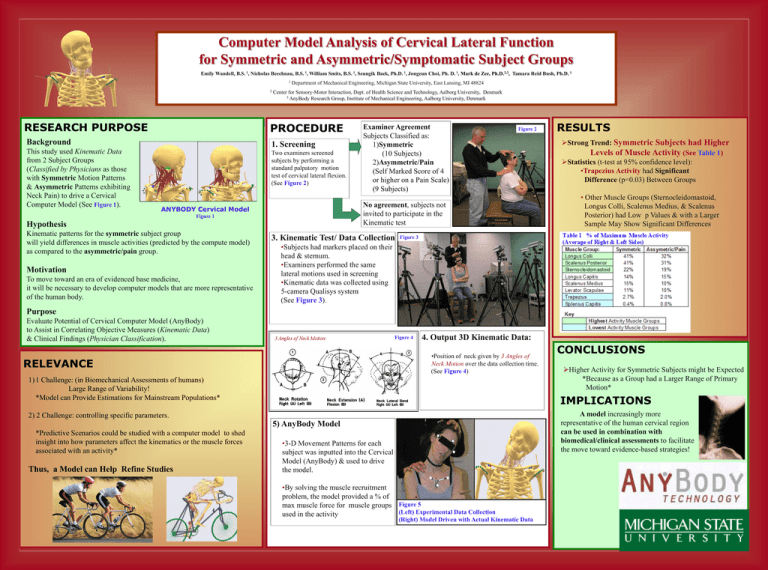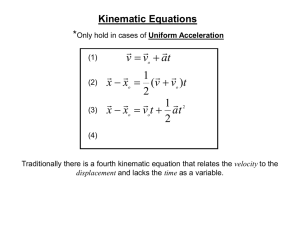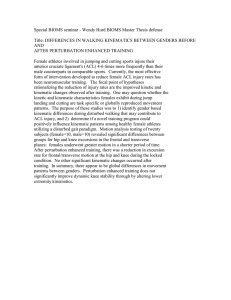Wandell Poster_Prese..
advertisement

Computer Model Analysis of Cervical Lateral Function for Symmetric and Asymmetric/Symptomatic Subject Groups Emily Wandell, B.S. 1, Nicholas Beechnau, B.S. 1, William Smits, B.S. 1, Seungik Baek, Ph.D. 1, Jongeun Choi, Ph. D. 1, Mark de Zee, Ph.D.2,3, Tamara Reid Bush, Ph.D. 1 1 2 Department of Mechanical Engineering, Michigan State University, East Lansing, MI 48824 Center for Sensory-Motor Interaction, Dept. of Health Science and Technology, Aalborg University, Denmark 3 AnyBody Research Group, Institute of Mechanical Engineering, Aalborg University, Denmark RESEARCH PURPOSE PROCEDURE Background 1. Screening This study used Kinematic Data from 2 Subject Groups (Classified by Physicians as those with Symmetric Motion Patterns & Asymmetric Patterns exhibiting Neck Pain) to drive a Cervical Computer Model (See Figure 1). Two examiners screened subjects by performing a standard palpatory motion test of cervical lateral flexion. (See Figure 2) Figure 1 Hypothesis Motivation To move toward an era of evidenced base medicine, it will be necessary to develop computer models that are more representative of the human body. Figure 2 No agreement, subjects not invited to participate in the Kinematic test ANYBODY Cervical Model Kinematic patterns for the symmetric subject group will yield differences in muscle activities (predicted by the compute model) as compared to the asymmetric/pain group. Examiner Agreement Subjects Classified as: 1)Symmetric (10 Subjects) 2)Asymmetric/Pain (Self Marked Score of 4 or higher on a Pain Scale) (9 Subjects) 3. Kinematic Test/ Data Collection RESULTS Strong Trend: Symmetric Subjects had Higher Levels of Muscle Activity (See Table 1) Statistics (t-test at 95% confidence level): •Trapezius Activity had Significant Difference (p=0.03) Between Groups • Other Muscle Groups (Sternocleidomastoid, Longus Colli, Scalenus Medius, & Scalenus Posterior) had Low p Values & with a Larger Sample May Show Significant Differences Figure 3 •Subjects had markers placed on their head & sternum. •Examiners performed the same lateral motions used in screening •Kinematic data was collected using 5-camera Qualisys system (See Figure 3). Purpose Evaluate Potential of Cervical Computer Model (AnyBody) to Assist in Correlating Objective Measures (Kinematic Data) & Clinical Findings (Physician Classification). Figure 4 4. Output 3D Kinematic Data: •Position of neck given by 3 Angles of Neck Motion over the data collection time. (See Figure 4) RELEVANCE 1) 1 Challenge: (in Biomechanical Assessments of humans) Large Range of Variability! *Model can Provide Estimations for Mainstream Populations* A model increasingly more representative of the human cervical region can be used in combination with biomedical/clinical assessments to facilitate the move toward evidence-based strategies! 5) AnyBody Model Thus, a Model can Help Refine Studies Higher Activity for Symmetric Subjects might be Expected *Because as a Group had a Larger Range of Primary Motion* IMPLICATIONS 2) 2 Challenge: controlling specific parameters. *Predictive Scenarios could be studied with a computer model to shed insight into how parameters affect the kinematics or the muscle forces associated with an activity* CONCLUSIONS •3-D Movement Patterns for each subject was inputted into the Cervical Model (AnyBody) & used to drive the model. •By solving the muscle recruitment problem, the model provided a % of max muscle force for muscle groups Figure 5 (Left) Experimental Data Collection used in the activity (Right) Model Driven with Actual Kinematic Data

